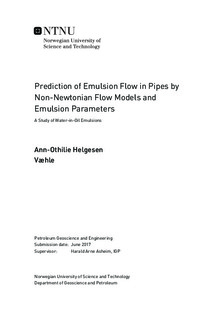| dc.description.abstract | The objective of this master s thesis is to measure emulsion properties, and check if these data combined with flow models enable prediction of emulsion flow in pipes. The two non-Newtonian flow models Power law and Herschel-Bulkley are used to predict flow rates, which will be compared to flow rates measured in a pipe.
Engine oil was used to prepare water-in-oil emulsions with varying water content. Shear stress, viscosity, droplet size distribution, temperature effect, aging and stability were investigated. One water-in-oil emulsion prepared from soybean oil was also used for comparison. Viscosity was increasing with increasing water content, and seemed to be slightly decreasing with aging. There was no clear trend for increased droplet size with aging.
Emulsion flow rates were measured in a specially designed flow facility. By combining emulsion parameters from laboratory measurements and the Power law and Herschel-Bulkley flow models, the flow rates were predicted. The averaged deviation between predicted and measured flow was 13%, and the maximum deviation was 35%. This is much above what would be expected for Newtonian fluid, but may be comparable for two-phase flow. | |

